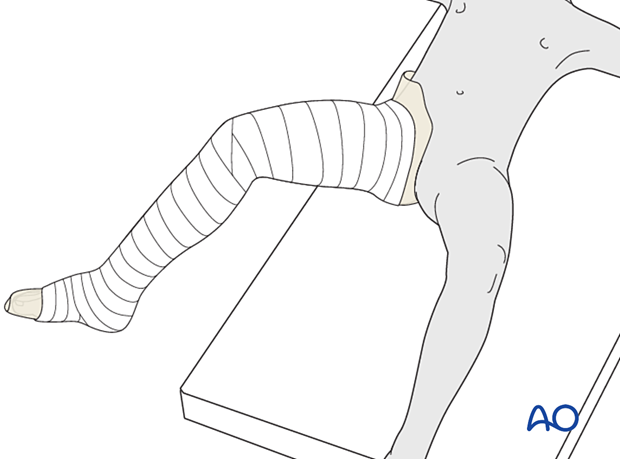Long leg cast
1. General considerations
Choice of immobilization
If there is severe soft-tissue swelling, it is safer to initially splint the limb, converting to a long leg cast when swelling has resolved.
It is important not to immobilize the limb for longer than 4 weeks to avoid knee stiffness. Conversion to a brace allows early mobilization of the knee.

Complications
- Compartment syndrome
- Pressure sore
Splinting
If severe swelling is interfering with circumferential casting, a splint may be applied until swelling resolves.
With the knee in 60° flexion, apply slabs of plaster of Paris posteriorly along the whole leg, covering half of the circumference.
Secure the splint with an elastic bandage.
2. Material
- Tubular bandage (stockinette) sized both for leg
- Cast padding
- Felt
- Casting material: fiberglass, plaster of Paris or a combination of both
- Water
The water should be tepid, or lukewarm, with an ideal temperature between 22° and 25° C.
Colder water, or a bandage that is wetter, increases working time, while warmer water, or a bandage that is drier, reduces the working time.

3. Cast application
Patient and leg positioning
Place the anesthetized patient supine on a radiolucent table. The patient should be positioned on the edge of the table or with a bump under the sacrum to facilitate bandaging into the groin.
An assistant supports the leg with 45°–60° hip flexion.
The patient’s knee should be flexed to approximately 60°, which will prevent the cast from slipping.

Dressing
Apply the tubular bandage and cut it slightly longer than the length of the final cast.

Padding
The distal edge of the cast extends to the base of the toes.
The proximal edge lies just above the greater trochanter on the lateral side, and just below the groin on the medial side.
Apply a layer of cast padding.
Consider adding thick felt over the padding at the free edges of the cast.
Overlap each layer by 1/2.
The tubular bandage and padding should be applied without creases.

Apply additional cast padding over the patella, malleoli, ankle, and heel, to protect these areas from pressure sores.
It should be appreciated that, when more padding is applied, there will be less support at the injury site.
Application of first cast layer
Apply a first layer of cast material to the leg starting distally.
Overlap each layer by 1/2.
Take care not to create sharp ridges at the level of the popliteal fossa.
Apply further layers of cast material to produce sufficient stability.

Fold the tubular bandage and padding over the edges before applying the final layer of casting material.

Final molding
While the cast is still soft, create a supracondylar mold and a varus or valgus mold to counter the potential direction of displacement, determined by the configuration and level of the fracture.
Gently mold the cast to the curve of the tibia and around the knee.
Pressure should be continued until the cast hardens.














